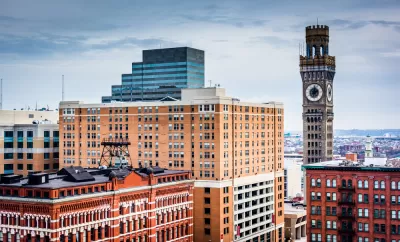The Reconnecting Communities Act would provide funding for retrofitting highway infrastructure and reconnecting neighborhoods cut off by road projects.

West Baltimore's notorious "Highway to Nowhere," a project "once intended to connect I-70 to downtown and link it to I-95 and I-83" but stopped due to community opposition, could be revitalized as part of a new federal grant program proposed by U.S. Senators Chris Van Hollen and Ben Cardin. As reported by Ron Cassie in Baltimore Magazine, the Reconnecting Communities Act "would establish a U.S. Department of Transportation grant program as part of President Joe Biden’s $2.25 trillion American Jobs Plan and assist communities in removing or retrofitting highway infrastructure that became an obstacle to mobility and economic opportunity."
The highway segment, while never completed, still had the effect of "dividing Black neighborhoods and serving as a stark example of the long history of inequity in infrastructure," according to Senator Van Hollen. The project displaced "more than 970 homes, 60 businesses, and 1,500 local residents." Since the halt of the project, a variety of redevelopment schemes have failed to come to fruition. The Red Line, a proposal to build a light rail line on the highway's median, was nixed by Governor Larry Hogan in 2015.
In 2018, "the Urban Land Institute—on behalf of the Baltimore Development Corporation—put together a report that suggested increased pedestrian infrastructure, more accessible green spaces and parks, and a retail hub and grocery store for the area could bridge the neighborhoods on each side of the highway. That study also suggested maintaining a 20-foot corridor in case the Red Line, or another mass transit project, is revived."
Mayor Brandon Scott praised the bill as a step toward "building a better Baltimore that eliminates concrete barriers to economic mobility and opportunity."
FULL STORY: Federal Lawmakers, City Officials Want Funding to End ‘Highway to Nowhere’

Maui's Vacation Rental Debate Turns Ugly
Verbal attacks, misinformation campaigns and fistfights plague a high-stakes debate to convert thousands of vacation rentals into long-term housing.

Planetizen Federal Action Tracker
A weekly monitor of how Trump’s orders and actions are impacting planners and planning in America.

In Urban Planning, AI Prompting Could be the New Design Thinking
Creativity has long been key to great urban design. What if we see AI as our new creative partner?

King County Supportive Housing Program Offers Hope for Unhoused Residents
The county is taking a ‘Housing First’ approach that prioritizes getting people into housing, then offering wraparound supportive services.

Researchers Use AI to Get Clearer Picture of US Housing
Analysts are using artificial intelligence to supercharge their research by allowing them to comb through data faster. Though these AI tools can be error prone, they save time and housing researchers are optimistic about the future.

Making Shared Micromobility More Inclusive
Cities and shared mobility system operators can do more to include people with disabilities in planning and operations, per a new report.
Urban Design for Planners 1: Software Tools
This six-course series explores essential urban design concepts using open source software and equips planners with the tools they need to participate fully in the urban design process.
Planning for Universal Design
Learn the tools for implementing Universal Design in planning regulations.
planning NEXT
Appalachian Highlands Housing Partners
Gallatin County Department of Planning & Community Development
Mpact (founded as Rail~Volution)
City of Camden Redevelopment Agency
City of Astoria
City of Portland
City of Laramie





























